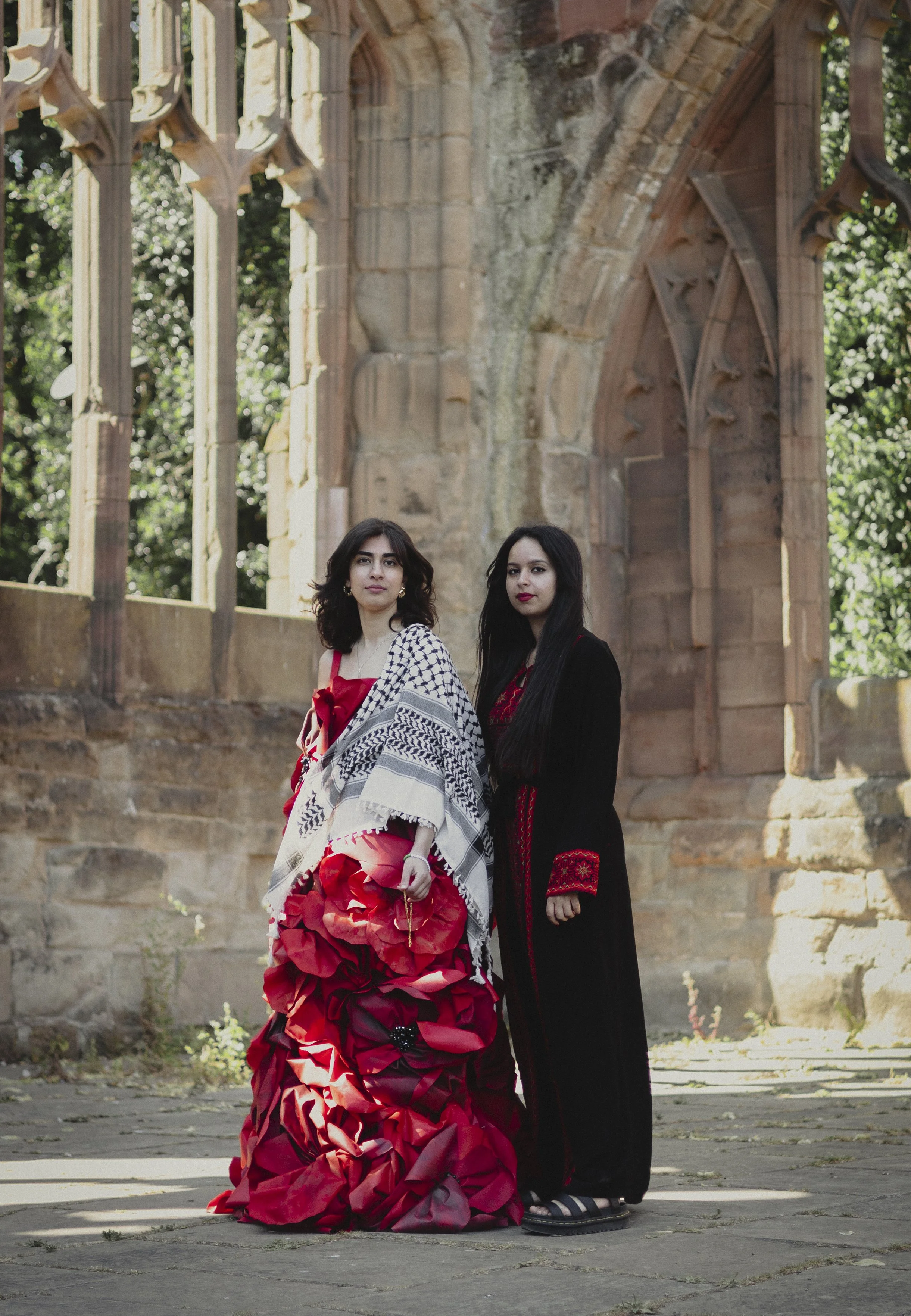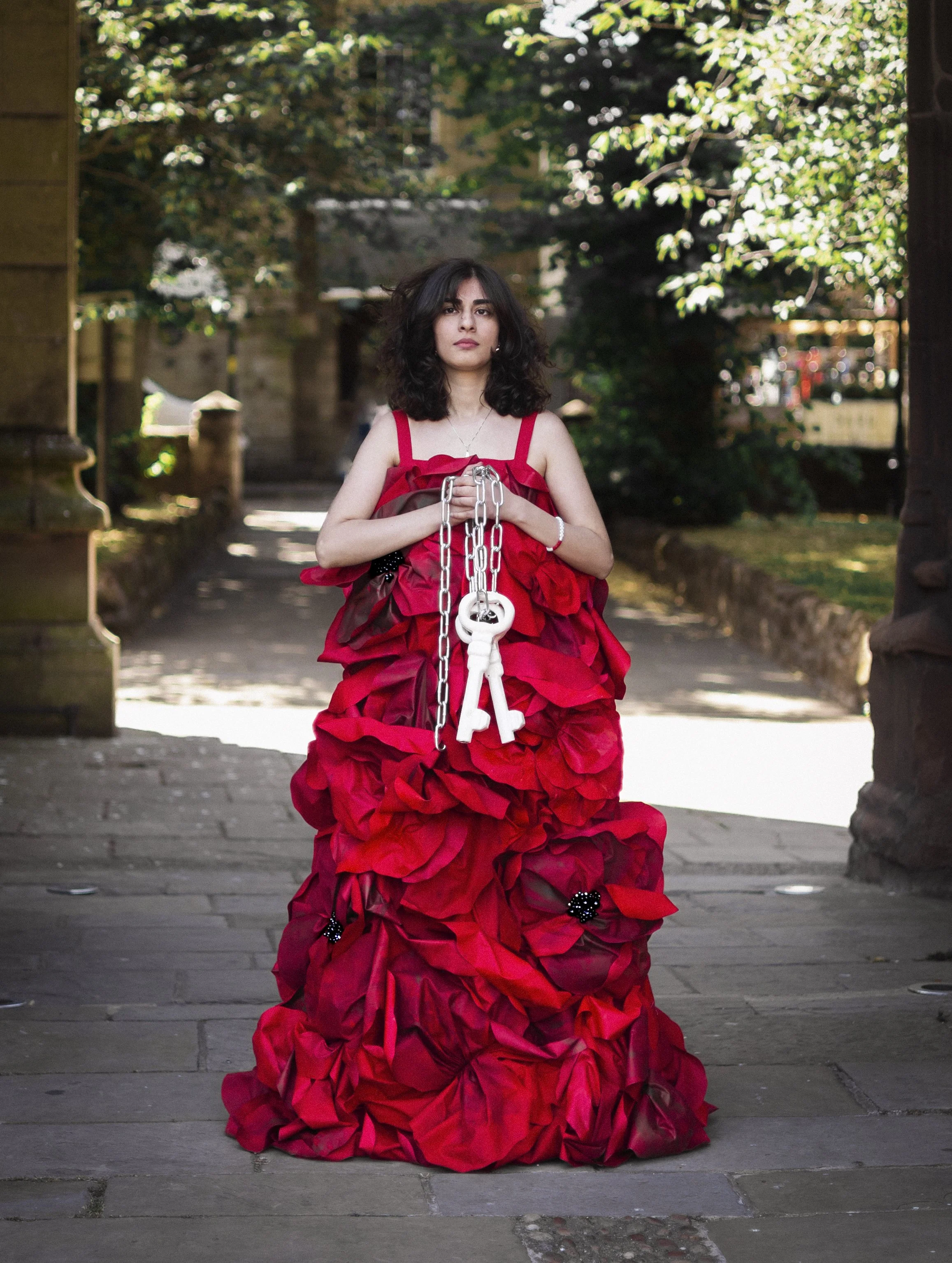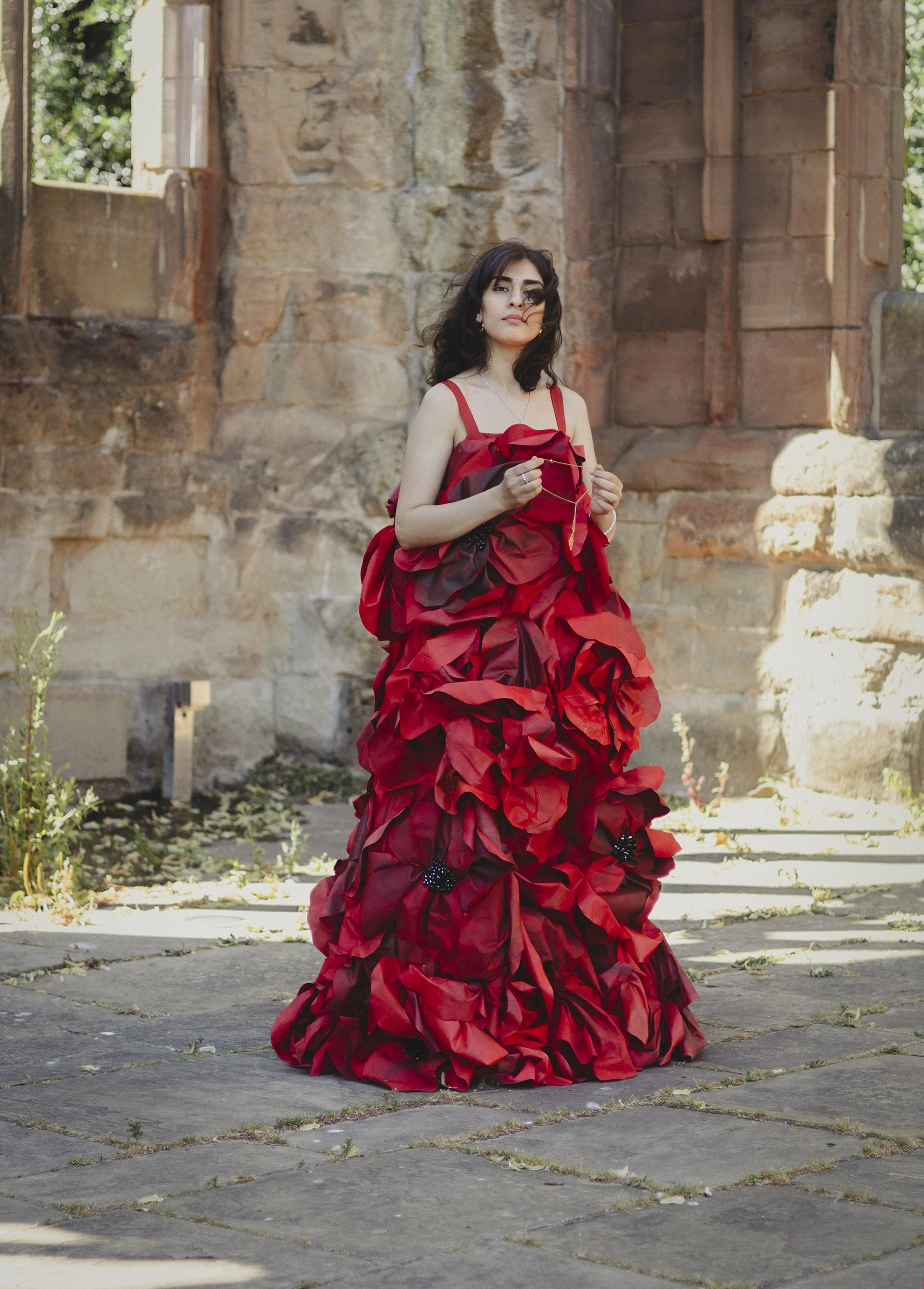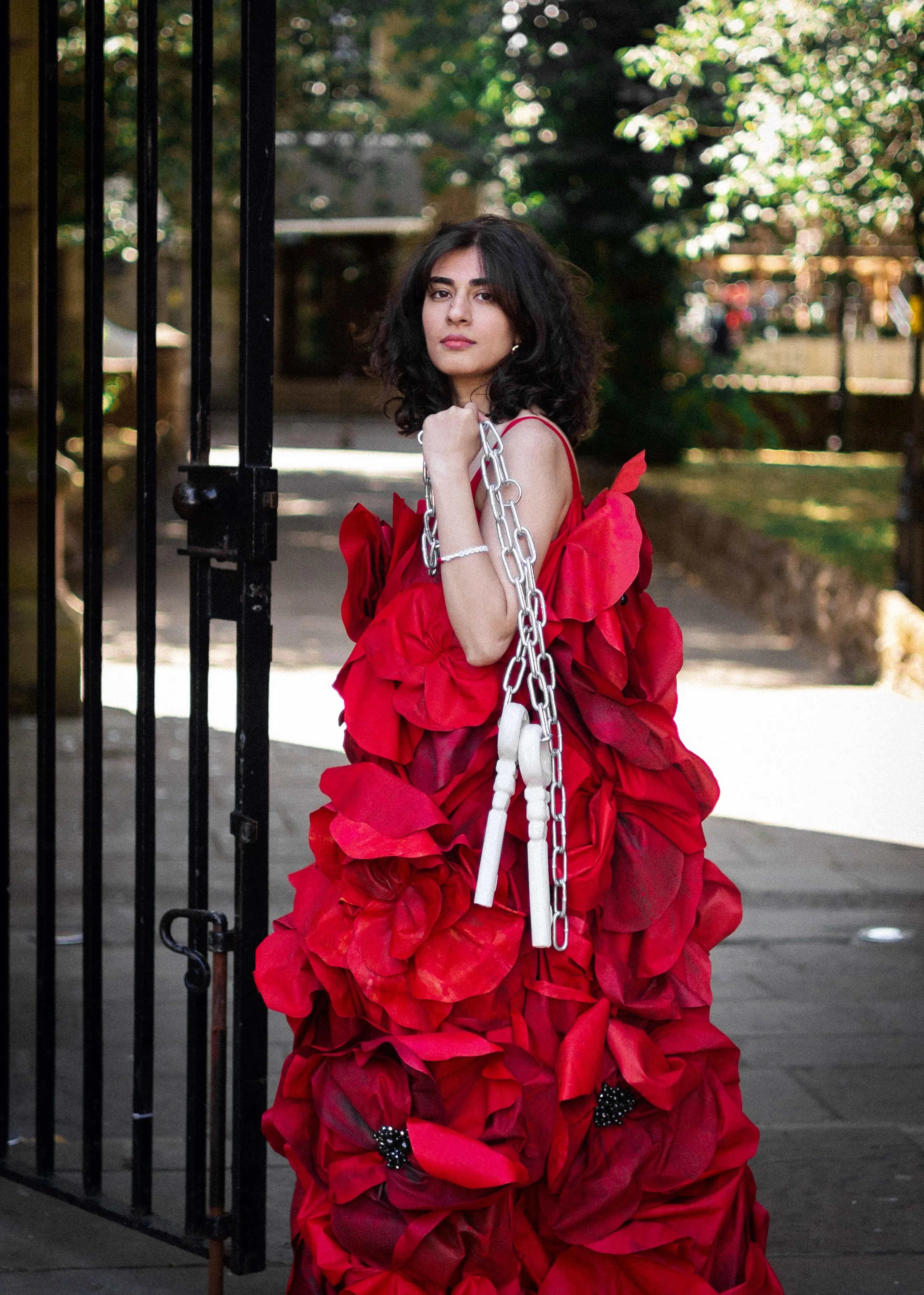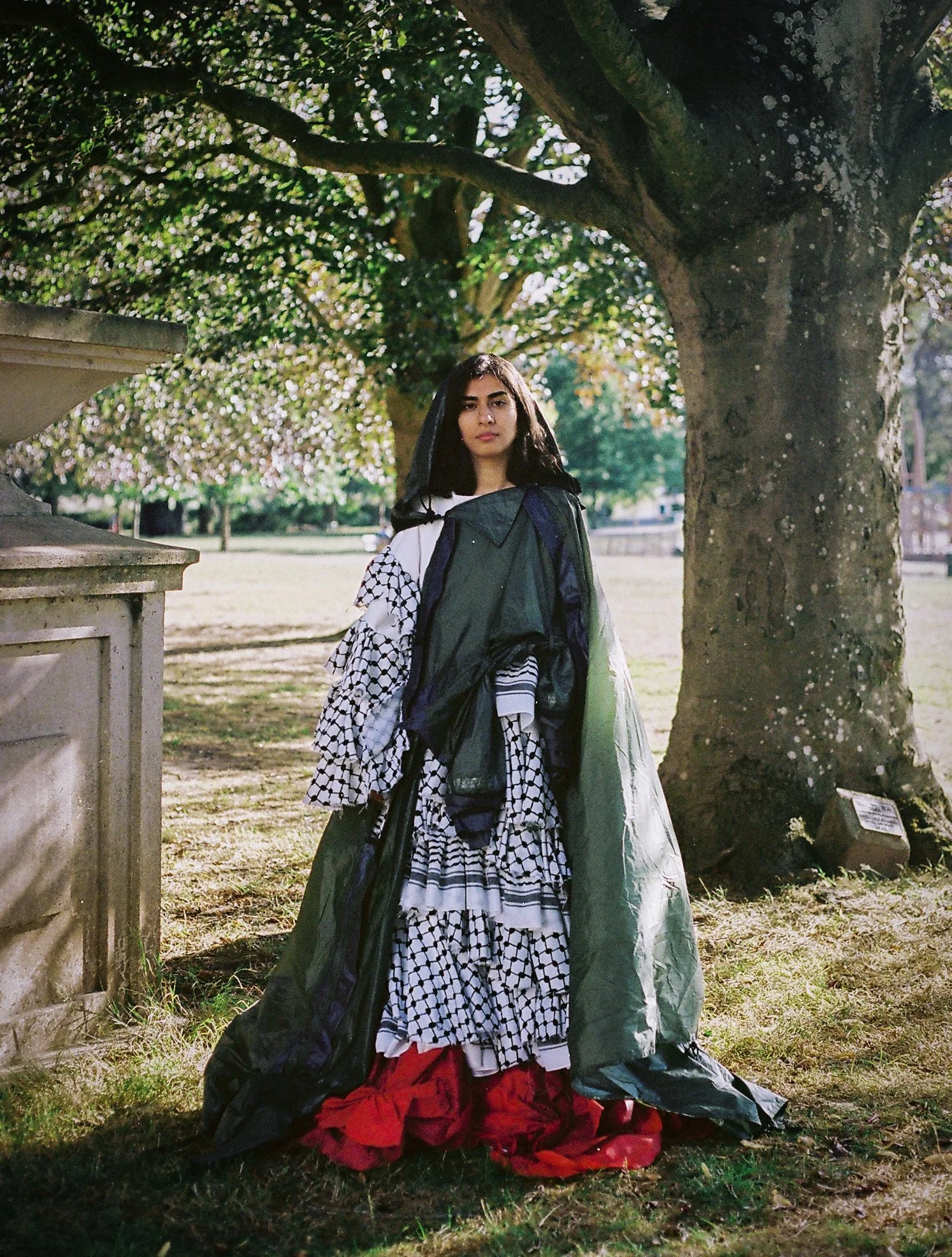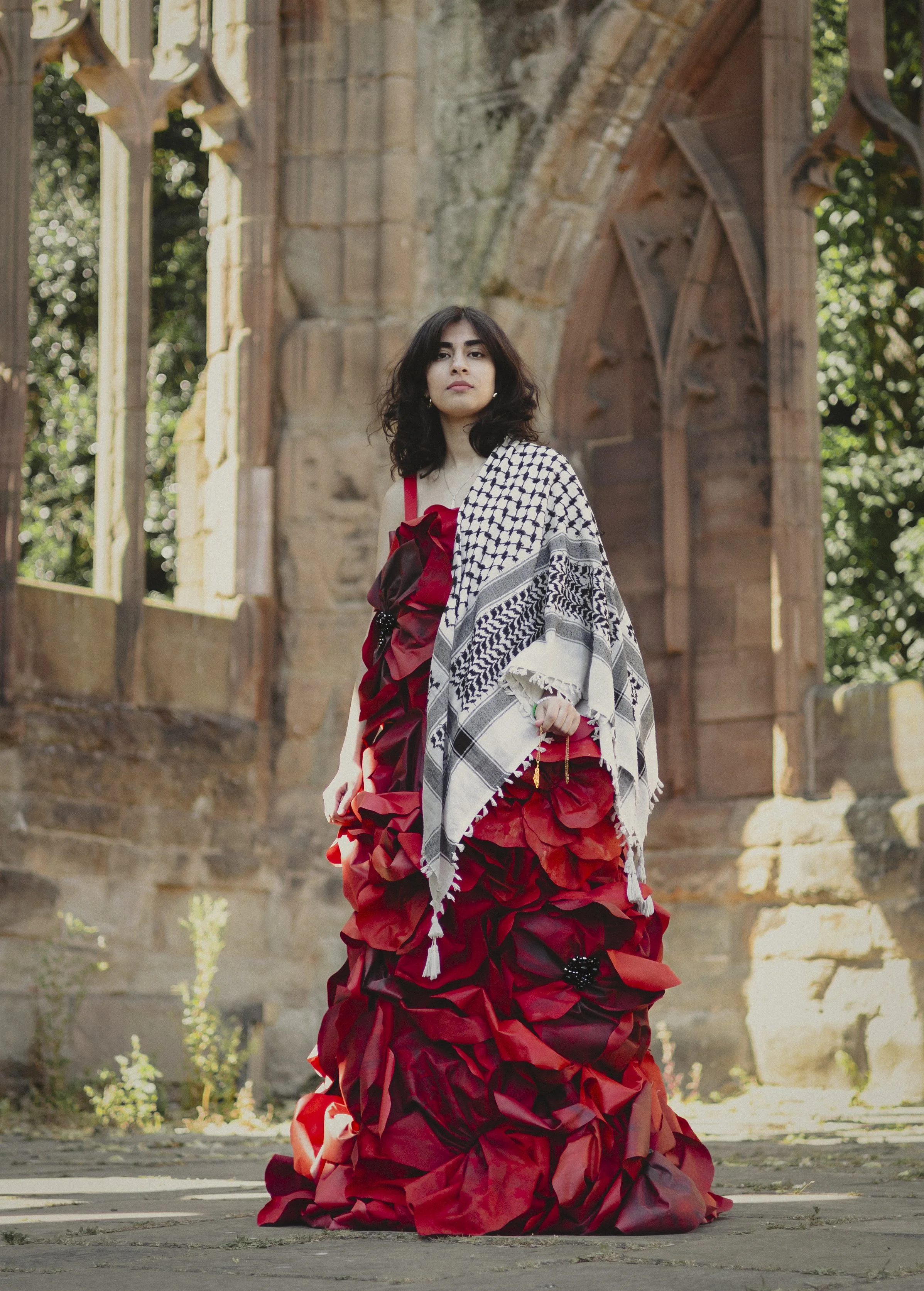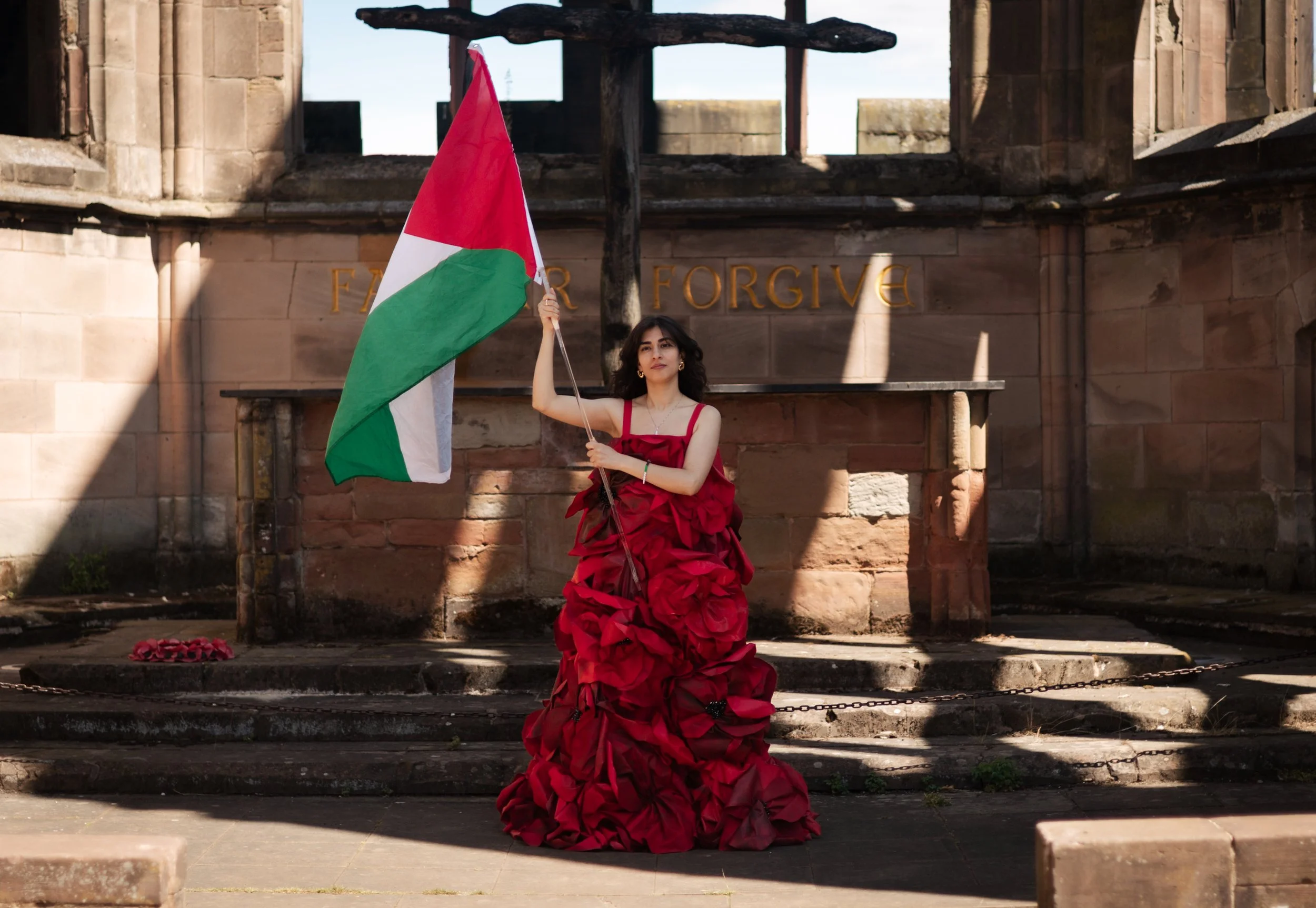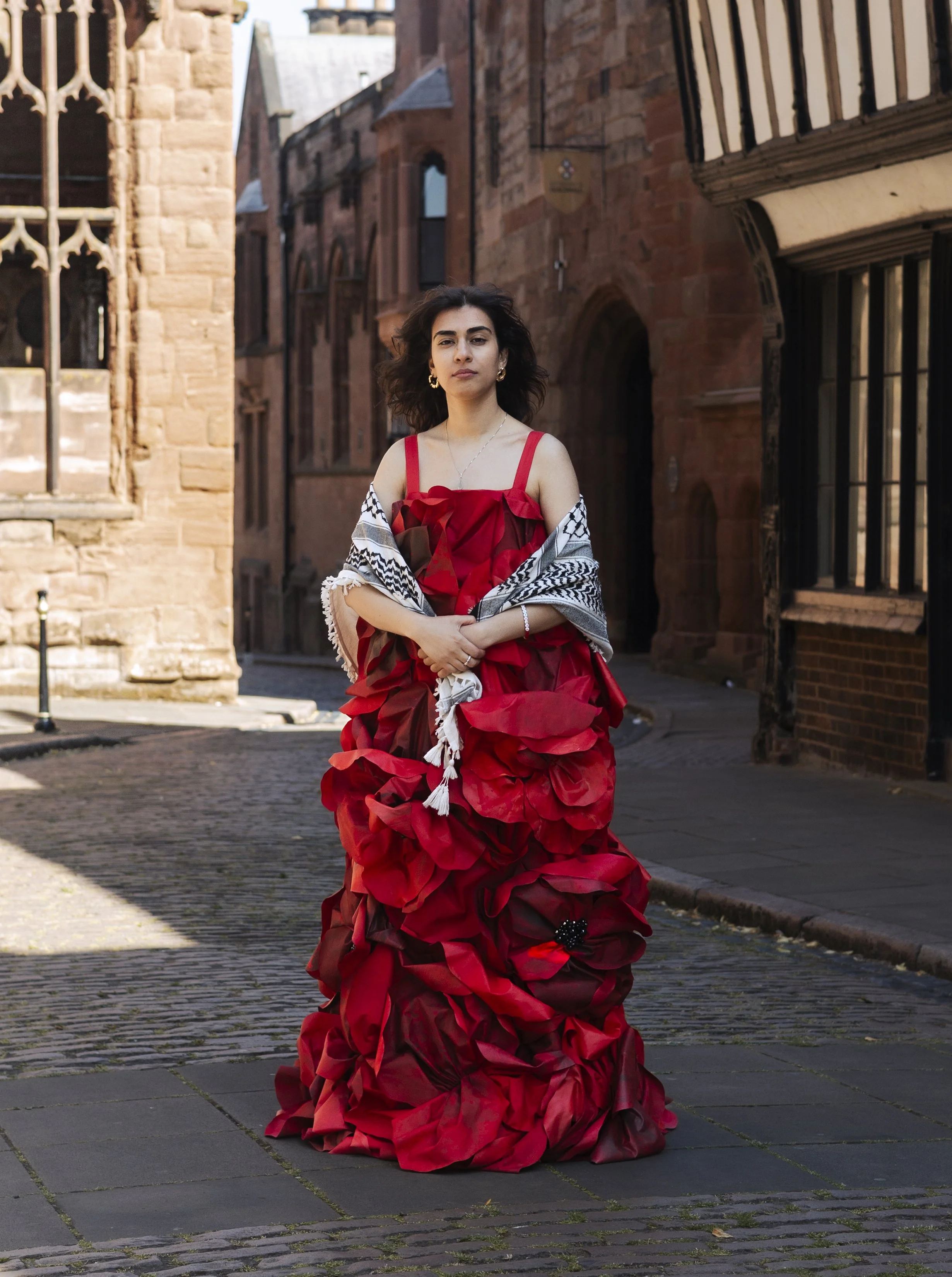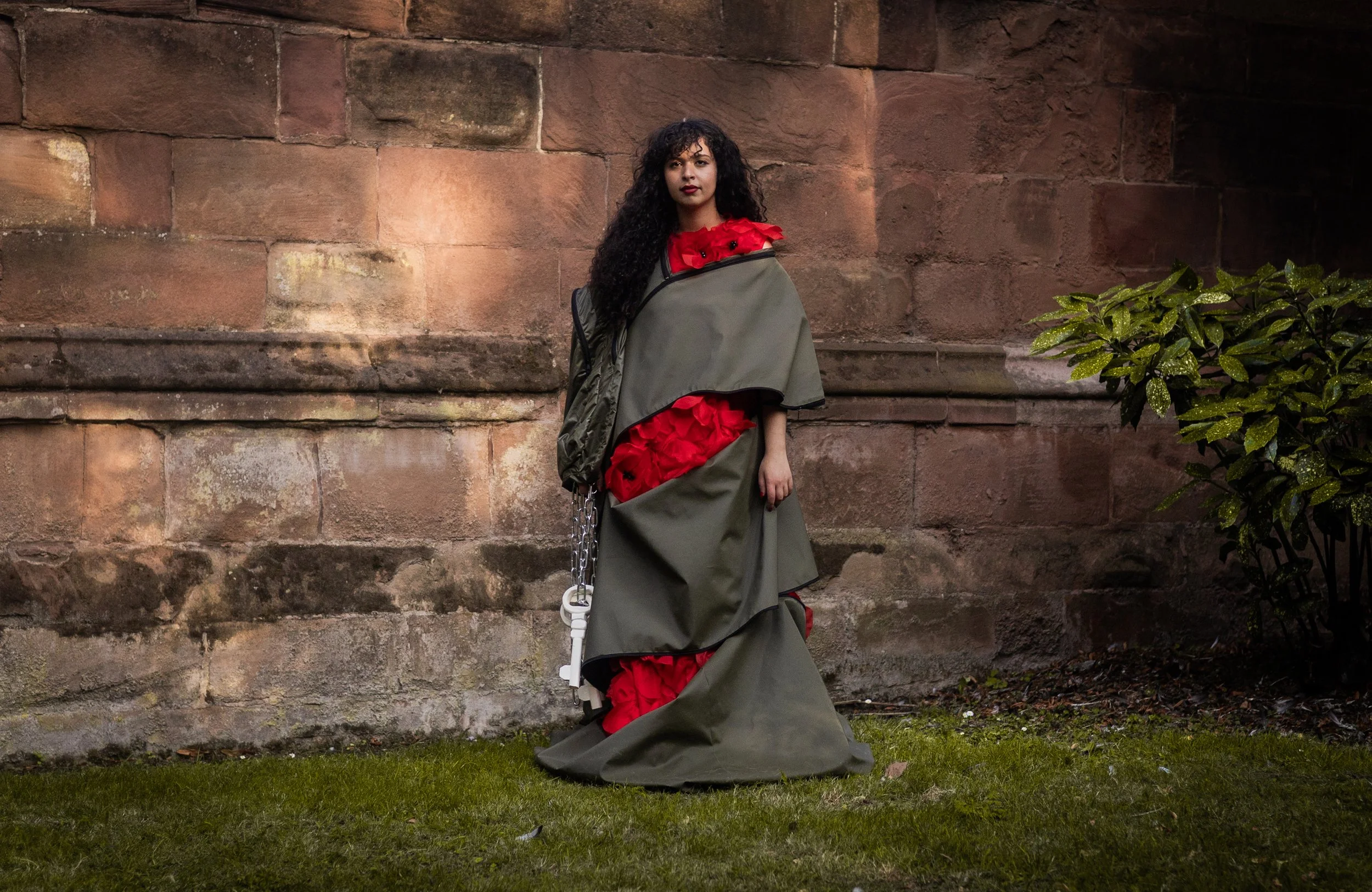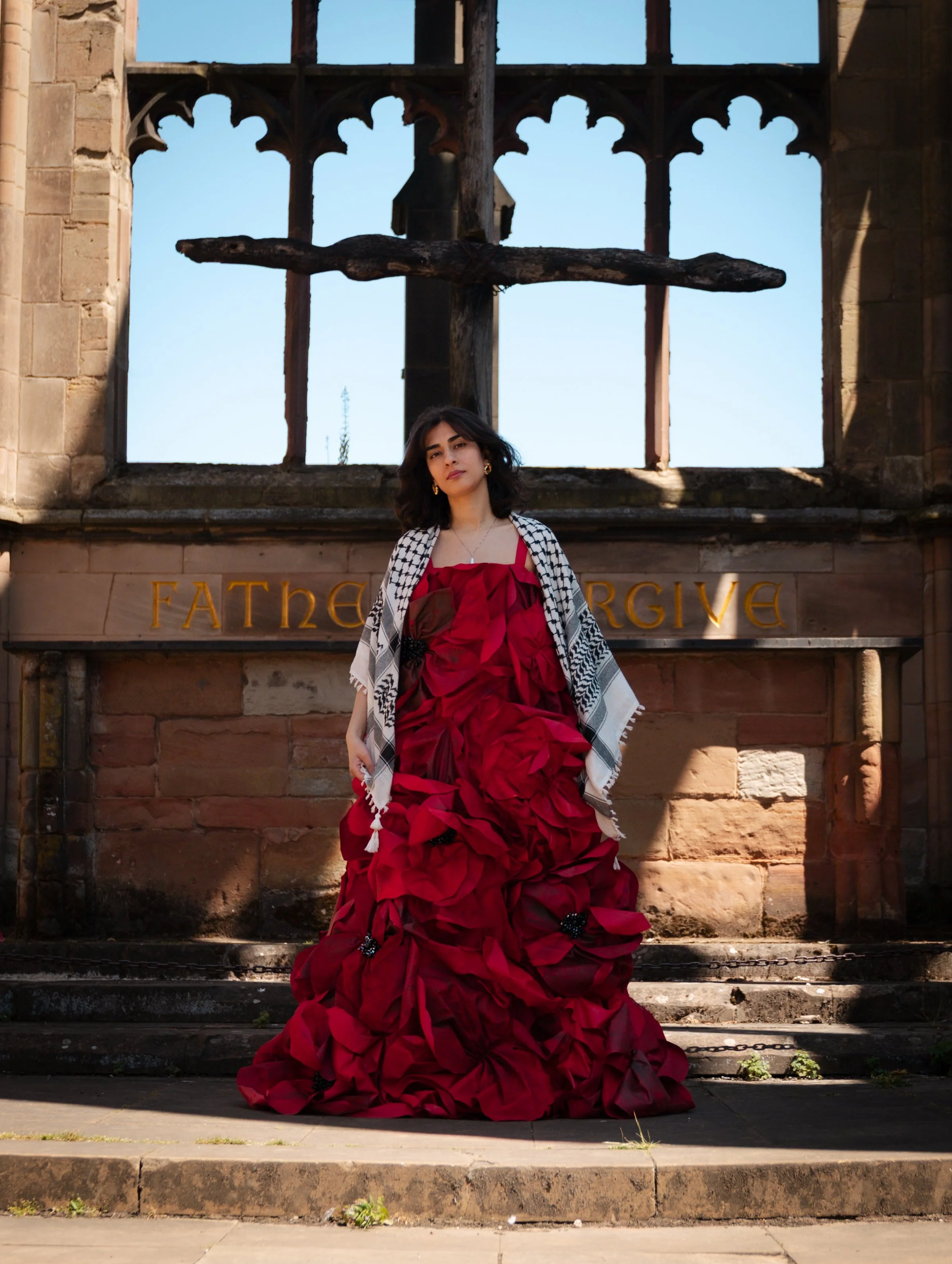Carrying Homeland, by Tala & Safa
Tala is a Palestinian fashion designer and recent graduate of Coventry University. Her final collection, Carrying Homeland, draws from personal and collective memory, rooted in the Palestinian experience of displacement, resilience, and creative survival. She was awarded the Culture & Heritage Award at Graduate Fashion Week 2025 and was recently named a finalist for YKK’s London Showroom Prize 2025.
Safa is a British-Pakistani social documentary and portrait photographer based in Birmingham, England. Her practice focuses on themes of cultural identity and underrepresented voices, using portraiture as a tool of storytelling. A 2024 graduate of Birmingham City University, Safa’s work has been exhibited in Women in Photo Birmingham and Free Range in London. She is a British Journal of Photography Portrait of Britain 2x shortlist (shortlist for volume 8, shortlist & winner for volume. 7) and recently awarded joint-Silver for the Emerging Talent Award at the Association of Photographers (AOP) 40th Anniversary Awards.
This interview brings together two emerging creatives whose practices are deeply intertwined with identity and protest. In this conversation, Safa and Tala reflect on collaboration, process, and the role of photography and fashion in telling stories that speak back to loss, longing, and cultural belonging.
Why did this project feel important to create?
SBM: This project ‘Draped In Resistance’ mattered to me on a personal, political and creative level. Tala’s collection held so much weight — materially, emotionally, symbolically — I remember watching the catwalk at GFW 2025 and thinking about how much the collection stood out amongst others, and what a significant moment it was for Palestine. Photographing it in my own way through a whole planned shoot felt like an act of honouring that. As a British-Pakistani, I’ve often felt the push-pull of distance and closeness when it comes to “homeland.” So building these visuals together — across British ruins, fields, architecture — became a way of anchoring those stories. A way to bring Palestine into conversation through these symbols that define both spaces in their own ways — to acknowledge the stories that get remembered and the ones that don’t. It wasn’t just about making something beautiful; it was about making space for resistance, memory, and dignity.
What do you enjoy about working with one another? The idea of collaborating with other creatives?
SBM: There’s something really energising about working with someone who cares as deeply as you do — not just about the outcome, but about what the work stands for. With Tala, that mutual care was there from the start. We both came into this collaboration with a shared sense of urgency, purpose, and cultural responsibility. She trusted me with her collection, and vision — and in that space, we were able to build something layered and intentional.
I love collaborations where you’re not just ticking boxes but genuinely thinking together. It’s not just about aesthetic or skill, it’s about trust, perspectives and shared intention. It opens a new way of seeing — they might challenge your framing, offer a detail you hadn’t considered, or hold you accountable to a deeper truth. And that’s where the power is.
I also got my younger sister Iman involved in these shoots — she’s Tala’s best friend from when they studied BA (Hons) Fashion together at Coventry University and she’s got that experience of professional styling. And so, Tala, Iman and I would bounce ideas, scout, rework things — always trying to make sure the imagery and styling felt true to the narrative and the land it evoked. There’s a kind of honesty that comes from working with people who bring lived experience to the table. That’s what I’ve come to value most: not just creating with someone, but holding space with them.
What would you like audiences to take from the imagery?
SBM: I want people to sit with the weight of it — not just the beauty. To recognise that these aren’t just styled portraits, but portraits carrying history, loss, survival, and power. I hope the imagery lingers in a way that prompts reflection: on whose stories are told, whose grief is acknowledged, and how fashion can hold something much deeper than trend. I want people to feel the tension — the softness and the resistance, the displacement and the pride — and come away understanding that these visuals aren’t passive. They speak. They reclaim. And they remember.
Maen Hammad, a Palestinian born photographer once said, “the camera is one of the most violent things probably produced on this planet,” speaking about his frustration with how the photography world treats Palestine. That stayed with me. This work felt like a response to that silence — to the visual erasure that often happens in editorial and photographic spaces.
And more than that — it was about challenging popular British platforms to actually see Palestinian culture as part of the diversity they claim to value. Not just in moments of crisis, but through the creativity, stories, and contributions of Palestinian artists and designers. I was lucky enough to have my work acknowledged by photography platforms like the Association of Photographers (AOP) recently where this series won Silver in their Emerging Talent Award. If we’re serious about inclusion, we need to make space for these narratives — not as exceptions, but as part of the cultural fabric.
What inspired you to create this collection?
TL: My inspiration comes from my Palestinian heritage and my personal experience growing up under occupation. Being from Gaza and living in the West Bank, I witnessed the realities of displacement, bombings and separation from my extended family firsthand. Creating this collection became a way for me to use fashion as a form of storytelling. I wanted to highlight the resilience and strength of the Palestinian people and raise awareness about the ongoing struggle for liberation.
What is the main message behind your collection?
TL: The collection aims to communicate the historical, political and cultural significance of Palestine. It focuses on forced displacement, which has been a central issue since the 1948 Nakba. Through my designs, I wanted to tell stories of resistance, hope and the strong connection between people and land. It’s about reclaiming our narrative and showing that even through hardship, there is beauty, strength and identity that cannot be erased.
Your collection blends material history with symbolism: tent fabric, keys, keffiyeh, poppies. Can you talk about what each of these elements meant to you when designing?
TL: Each element in my collection represents a layer of the Palestinian struggle for liberation. The tent fabric reflects forced displacement and the ongoing reality of living under occupation. It’s a material that carries the weight of loss of home and resilience. The keys which are made out of porcelain symbolize the hope of return to their homes and the unbroken connection Palestinians have to their land. The keffiyeh stands for unity and resistance, both historically and today so using authentic fabric from Palestine felt important and genuine. The poppies represent the lives of martyrs and the relationship between people and land they speak of sacrifice, love and resistance. Each material became a way for me to translate emotion into form, turning fashion into a language of remembrance and resistance.
How did it feel to bring this collection into public space through photography, as well as the context of a runway or gallery?
TL: It felt important and urgent to share the story of Palestine and to raise awareness on what’s happening there. Through photography, I could express the emotional experience of displacement, layering and weight both literal and symbolic.
Where do you want ‘Carrying Homeland’ to go next, physically or metaphorically?
TL: Physically, I’d like the project to continue evolving through exhibitions, collaborations, or partnerships. Metaphorically, Carrying Homeland will always grow with me. It’s the foundation of my vision to build a brand that combines fashion, activism and storytelling. My work will always speak about injustice and uses creativity as a form of resistance.This project was my first step in my journey in fashion and I will continue to carry my homeland with me, wherever my work goes next.
How did you approach capturing the themes of displacement, resilience, and identity in this collection?
SBM: For me, it started with the intention to create images that carried the weight of what this collection stood for — not just visually, but emotionally. Displacement isn’t just something you show through setting or props; it’s something that lives in the posture, in the material, in the light. The ruins and fields of Coventry weren’t just locations — they were echoes, holding space for both memory and loss. I thought a lot about resilience not as something loud or explosive, but something quiet and insistent. The way fabric clings in the wind. The way a body stands tall in silence. And identity — that came through in the textures: the keffiyeh, the poppies, the tent fabric. They weren’t just design elements, they were cultural memory stitched in. I wanted every frame to feel like an act of holding on — and of refusing to let go.
How did working with the designs influence your creative choices during the photoshoot?
SBM: The designs absolutely shaped the visual language of the shoot. Your garments aren’t just clothes — they’re layered with meaning, from the keffiyeh detailing to the tent-fabric silhouettes. That naturally pushed me to move beyond traditional fashion imagery. I approached it less like a commercial shoot and more like a portrait of protest — something that required stillness, gravity, and time. The red poppies, for example, demanded framing that echoed both remembrance and disruption. The oversized shapes of the pieces led me to compose wider, more spacious frames to let the garments breathe. Even the movement — or lack of it — in the shots was intentional. I wanted the viewer to really see the fabric. To witness the design. To pause, not scroll. The clothes didn’t just influence the aesthetic — they determined the rhythm and mood of the entire shoot.
Were there any moments during the shoot that stood out to you emotionally or creatively?
SBM: What stood out most to me was how deeply the locations shaped the narrative. From the beginning, I was drawn to the idea of pairing the pieces in your collection with spaces in Coventry that carried the weight of memory — sites linked to war memorials, remembrance, and loss. These weren’t just backdrops; they were part of the story. Especially also because you moved here at the age of 15. This place also helped shape who you are as an emerging fashion designer so there was that deeper connection to this city.
Whether it was shooting in the ruins, in front of the ancient church doors, or in the middle of an open field — every setting offered something distinct. Even that field wasn’t just any field; it was the War Memorial Park, a site that honours British lives lost in war. But rather than centre that narrative, I wanted to reframe the space to tell another story: that of two Palestinian women who came to the UK to study, create, and give something back to their people through their work.
For me, that juxtaposition — of British memorial architecture with Palestinian resilience and artistry — became incredibly powerful. The red poppy used throughout these spaces is widely associated with British remembrance. But the red anemone poppy is also the national flower of Palestine. That overlap became a quiet but vital part of the visuals. It became about how culture, memory, and identity can intersect — and about how visual storytelling can honour that.
Creatively, that was the most important element of the shoot: using space to elevate the story. Letting place and portrait speak to each other. That dialogue between fabric and environment, history and present, gave the imagery its emotional charge.
Is there a particular image that you feel best represents the message of the collection, and why?
SBM: Personally, I can’t pick a single favourite. I think they all hold power in different ways — and together, they tell the story. The portraits of Shams wearing the poppy dress, shot both in the ruins and the open field, were part of a creative experiment with setting — and I really feel like that experiment worked. The ruins spoke to survival, the layers of memory. The field — wide and open — became a space of quiet defiance. And then there are others — portraits surrounded by nature, where tent fabric scraps and keffiyeh overlays are woven into trees, caught by the light. That felt important too. The dress is made of flowers, after all — poppies. But it also nods to something heavier: tents, displacement, suffering.
Whether it was pairing the poppy dress with a keffiyeh, or holding the keys of return, or capturing the tent dress with the keffiyeh woven directly into it — they all carry the same core message. That Palestinians are strong. That they carry resilience. That their roots run deep — and that even when they’re far from home, their bond with Palestine endures.
These images are about not forgetting. Not being erased. They’re about remembering who you are, wherever you are — and that’s already something so important to me personally — as a British-Pakistani, as someone of colour, as someone with another place far from here that I also call home. I understand what it means to hold onto your roots. To honour where you come from.

